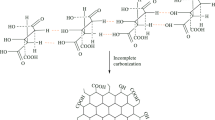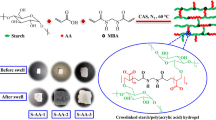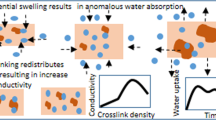Abstract
Poly(N-isopropylacrylamide)-based ionic hydrogels were synthesized by free-radical polymerization with N-isopropylacrylamide as a monomer and imidazolium-based dicationic ionic liquid as a crosslinker. The dicationic crosslinkers [Cn(Vim)2][Br]2 were obtained by quaternizing 1-vinylimidazole (Vim) with dibromo compounds (Br-CnH2n-Br) with various alkyl chain length n, respectively. The effects of alkyl chain length and the amounts of crosslinker on the structure, swelling properties, interfacial adsorption and release of anionic dyes of the obtained ionic hydrogels were systematically investigated by using scanning electron microscopy, Fourier transform infrared spectroscopy and ultraviolet–visible spectroscopy. The obtained ionic hydrogels showed good swelling properties and typical feature of poly(ionic liquid) in aqueous solutions, of which the quaternized imidazolium moieties could interfacially interact with anionic dyes, such as methyl orange, methyl blue, congo red, orange G, thymol blue and bromothymol blue. Different kinetic and adsorption isotherm models were used to describe the interfacial adsorption and release behaviors of anionic dyes, which were strongly dependent on the chemical structures of the dyes.
Similar content being viewed by others
Log in or create a free account to read this content
Gain free access to this article, as well as selected content from this journal and more on nature.com
or
References
Chen, Q., Zhu, L., Zhao, C., Wang, Q. & Zheng, J. A robust, one-pot synthesis of highly mechanical and recoverable double network hydrogels using thermoreversible sol–gel polysaccharide. Adv. Mater. 25, 4171–4176 (2013).
Tan, M., Zhao, T., Huang, H. & Guo, M. Highly stretchable and resilient hydrogels from the copolymerization of acrylamide and a polymerizable macromolecular surfactant. Polym. Chem. 4, 5570–5576 (2013).
Sun, J., Zhao, X., Illeperuma, W. R. K., Chaudhuri, O., Oh, K. H., Mooney, D. J., Vlassak, J. J. & Suo, Z. Highly stretchable and tough hydrogels. Nature 489, 133–136 (2012).
Li, Z., Xiang, Y., Zhou, X., Nie, J., Peng, M. & Du, B. Thermo-sensitive poly(DEGMMA-co-MEA) microgels: synthesis, characterization and interfacial interaction with adsorbed protein layer. Chin. J. Polym. Sci. 33, 1516–1526 (2015).
Vermonden, T., Censi, R. & Hennink, W. E. Hydrogels for protein delivery. Chem. Rev. 112, 2853–2888 (2012).
Kim, D. & Beebe, D. J. Hydrogel-based reconfigurable components for microfluidic devices. Lab Chip 7, 193–198 (2007).
Buenger, D., Topuz, F. & Groll, J. Hydrogels in sensing applications. Prog. Polym. Sci. 37, 1678–1719 (2012).
Lee, K. Y. & Mooney, D. J. Hydrogels for tissue engineering. Chem. Rev. 101, 1869–1879 (2001).
Kopecek, J. Hydrogels: from soft contact lenses and implants to self-assembled nanomaterials. J. Polym. Sci. Part A 47, 5929–5946 (2009).
Calvert, P. Hydrogels for soft machines. Adv. Mater. 21, 743–756 (2009).
Peppas, N. A., Hilt, J. Z., Khademhosseini, A. & Langer, R. Hydrogels in biology and medicine: from molecular principles to bionanotechnology. Adv. Mater. 18, 1345–1360 (2006).
Slaughter, B. V., Khurshid, S. S., Fisher, O. Z., Khademhosseini, A. & Peppas, N. A. Hydrogels in regenerative medicine. Adv. Mater. 21, 3307–3329 (2009).
Van Vlierberghe, S., Dubruel, P. & Schacht, E. Biopolymer-based hydrogels as scaffolds for tissue engineering applications: a review. Biomacromolecules 12, 1387–1408 (2011).
Sangeetha, N. M. & Maitra, U. Supramolecular gels: functions and uses. Chem. Soc. Rev. 34, 821–836 (2005).
Nguyen, K. T. & West, J. L. Photopolymerizable hydrogels for tissue engineering applications. Biomaterials 23, 4307–4314 (2002).
Yu, L. & Ding, J. Injectable hydrogels as unique biomedical materials. Chem. Soc. Rev. 37, 1473–1481 (2008).
Parvulescu, V. I. & Hardacre, C. Catalysis in ionic liquids. Chem. Rev. 107, 2615–2665 (2007).
Yuan, J., Soll, S., Drechsler, M., Mueller, A. H. E. & Antonietti, M. Self-assembly of poly(ionic liquid)s: polymerization, mesostructure formation, and directional alignment in one step. J. Am. Chem. Soc. 133, 17556–17559 (2011).
Armand, M., Endres, F., MacFarlane, D. R., Ohno, H. & Scrosati, B. Ionic-liquid materials for the electrochemical challenges of the future. Nat. Mater. 8, 621–629 (2009).
Giernoth, R. Task-specific ionic liquids. Angew. Chem. Int. Ed. 49, 2834–2839 (2010).
Xiong, Y., Liu, J., Wang, Y., Wang, H. & Wang, R. One-step synthesis of thermosensitive nanogels based on highly cross-linked poly(ionic liquid)s. Angew. Chem. Int. Ed. 51, 9114–9118 (2012).
Suzuki, K., Yamaguchi, M., Hotta, S., Tanabe, N. & Yanagida, S. A new alkyl-imidazole polymer prepared as an inonic polymer electrolyte by in situ polymerization of dye sensitized solar cells. J. Photochem. Photobiol. A 164, 81–85 (2004).
Li, F., Cheng, F., Shi, J., Cai, F., Liang, M. & Chen, J. Novel quasi-solid electrolyte for dye-sensitized solar cells. J. Power Sources 165, 911–915 (2007).
Zhang, Y., Zhao, L., Patra, P. K., Hu, D. & Ying, J. Y. Colloidal poly-imidazolium salts and derivatives. Nano Today 4, 13–20 (2009).
Yuan, C., Guo, J. & Yan, F. Shape memory poly(ionic liquid) gels controlled by host-guest interaction with beta-cyclodextrin. Polymer 55, 3431–3435 (2014).
Yuan, C., Guo, J., Si, Z. & Yan, F. Polymerization in ionic liquid-based microemulsions. Polym. Chem. 6, 4059–4066 (2015).
Yuan, C., Guo, J., Tan, M., Guo, M., Qiu, L. & Yan, F. Multistimuli responsive and electroactive supramolecular gels based on ionic liquid gemini guest. ACS Macro Lett. 3, 271–275 (2014).
Crini, G. Non-conventional low-cost adsorbents for dye removal: a review. Bioresour. Technol. 97, 1061–1085 (2006).
Forgacs, E., Cserhati, T. & Oros, G. Removal of synthetic dyes from wastewaters: a review. Environ. Int. 30, 953–971 (2004).
Bhattacharyya, K. G. & Sharma, A. Kinetics and thermodynamics of methylene blue adsorption on neem (azadirachta indica) leaf powder. Dyes Pigm 65, 51–59 (2005).
Alves de Lima, RO, Bazo, AP, Salvadori, DM, Rech, CM, de Palma Oliveira, D & de Aragão Umbuzeiro, G Mutagenic and carcinogenic potential of a textile azo dye processing plant effluent that impacts a drinking water source. Mutat. Res. Genet. Toxicol. Environ. Mutagen 626, 53–60 (2007).
Carneiro, P. A., Umbuzeiro, G. A., Oliveira, D. P. & Zanoni, M. V. B. Assessment of water contamination caused by a mutagenic textile effluent/dyehouse effluent bearing disperse dyes. J. Hazard. Mater. 174, 694–699 (2010).
Nguyen, Le, M. T. & Lee, B. K. High temperature synthesis of interfacial functionalized carboxylate mesoporous TiO2 for effective adsorption of cationic dyes. Chem. Eng. J. 281, 20–33 (2015).
Hao, O. J., Kim, H. & Chiang, P. C. Decolorization of wastewater. Crit. Rev. Environ. Sci. Technol. 30, 449–505 (2000).
Zhou, X., Zhou, Y., Nie, J., Ji, Z., Xu, J., Zhang, X. & Du, B. Thermosensitive ionic microgels via surfactant-free emulsion copolymerization and in situ quaternization cross-linking. ACS Appl. Mater. Interfaces 6, 4498–4513 (2014).
Zhou, X., Nie, J., Wang, Q. & Du, B. Thermosensitive ionic microgels with pH tunable degradation via in situ quaternization cross-linking. Macromolecules 48, 3130–3139 (2015).
Zhou, X., Nie, J., Xu, J. & Du, B. Thermo-sensitive ionic microgels via post quaternization cross-linking: fabrication, property, and potential application. Colloid. Polym. Sci. 293, 2101–2111 (2015).
Zhou, X., Nie, J. & Du, B. 4-(2-Pyridylazo)-resorcinol functionalized thermosensitive ionic microgels for optical detection of heavy metal ions at nanomolar level. ACS Appl. Mater. Interfaces 7, 21966–21974 (2015).
Sandeman, S. R., Gun'ko, V. M., Bakalinska, O. M., Howell, C. A., Zheng, Y., Kartel, M. T., Phillips, G. J. & Mikhalovsky, S. V. Adsorption of anionic and cationic dyes by activated carbons, PVA hydrogels, and PVA/AC composite. J. Colloid Interface Sci. 358, 582–592 (2011).
Chen, T., Du, B. & Fan, Z. Organic–inorganic hybrid mesoporous polymers fabricated by using (CTA)(2)S2O8 as self-decomposed soft templates. Langmuir 28, 15024–15032 (2012).
Langmuir, I. The adsorption of gases on plane surfaces of glass, mica and platinum. J. Am. Chem. Soc. 40, 1361–1403 (1918).
Mall, I. D., Srivastava, V. C. & Agarwal, N. K. Removal of orange-G and methyl violet dyes by adsorption onto bagasse fly ash—kinetic study and equilibrium isotherm analyses. Dyes Pigm 69, 210–223 (2006).
Freundlich, H. Concerning adsorption in solutions. J. Phys. Chem. 57, 385 (1906).
Rekha, P., Muhammad, R. & Mohanty, P. Sonochemical synthesis of cyclophosphazene bridged mesoporous organosilicas and their application in methyl orange, congo red and Cr(VI) removal. RSC Adv. 5, 67690–67699 (2015).
Chen, H., Zhao, J., Wu, J. & Dai, G. Isotherm, thermodynamic, kinetics and adsorption mechanism studies of methyl orange by surfactant modified silkworm exuviae. J. Hazard. Mater. 192, 246–254 (2011).
Salama, A., Shukry, N. & El-Sakhawy, M. Carboxymethyl cellulose-g-poly(2-(dimethylamino) ethyl methacrylate) hydrogel as adsorbent for dye removal. Int. J. Biol. Macromol. 73, 72–75 (2015).
Zhang, F., Zhao, Z., Tan, R., Guo, Y., Cao, L., Chen, L., Li, J., Xu, W., Yang, Y. & Song, W. Selective and effective adsorption of methyl blue by barium phosphate nano-flake. J. Colloid Interface Sci. 386, 277–284 (2012).
Wang, S., Gao, Q., Luo, W. J., Xu, J., Zhou, C. G. & Xia, H. Removal of methyl blue from aqueous solution by magnetic carbon nanotube. Water Sci. Technol. 68, 665–673 (2013).
Dawood, S., Sen, T. K. & Phan, C. Synthesis and characterisation of novel-activated carbon from waste biomass pine cone and its application in the removal of congo red dye from aqueous solution by adsorption. Water Air Soil Pollut. 225 (2014).
Yang, X. & Ni, L. Synthesis of hybrid hydrogel of poly(AM co DADMAC)/silica sol and removal of methyl orange from aqueous solutions. Chem. Eng. J. 209, 194–200 (2012).
Chatterjee, S., Lee, M. W. & Woo, S. H. Adsorption of congo red by chitosan hydrogel beads impregnated with carbon nanotubes. Bioresour. Technol. 101, 1800–1806 (2010).
Zhu, H. Y., Fu, Y. Q., Jiang, R., Yao, J., Xiao, L. & Zeng, G. M. Novel magnetic chitosan/poly(vinyl alcohol) hydrogel beads: preparation, characterization and application for adsorption of dye from aqueous solution. Bioresour. Technol. 105, 24–30 (2012).
Acknowledgements
We thank the National Natural Science Foundation of China (Nos. 21274129 and 21322406), the Fundamental Research Funds for the Central Universities (2014XZZX003-21) and the third level of 2013 Zhejiang Province 151 Talent Project for financial supports.
Author information
Authors and Affiliations
Corresponding authors
Ethics declarations
Competing interests
The authors declare no conflict of interest.
Additional information
Supplementary Information accompanies the paper on Polymer Journal website
Supplementary information
Rights and permissions
About this article
Cite this article
Zhou, X., Wang, J., Nie, J. et al. Poly(N-isopropylacrylamide)-based ionic hydrogels: synthesis, swelling properties, interfacial adsorption and release of dyes. Polym J 48, 431–438 (2016). https://doi.org/10.1038/pj.2015.123
Received:
Revised:
Accepted:
Published:
Issue date:
DOI: https://doi.org/10.1038/pj.2015.123
This article is cited by
-
Fabrication and evaluation of smart pH/thermo dual-responsive injectable intratumoral in situ depot hydrogels for controlled 5-FU delivery
Beni-Suef University Journal of Basic and Applied Sciences (2023)
-
Synthesis and characterization of cryogels of p(HEMA-N-vinylformamide) and p(HEMA-N-Vinylpyrrolidone) for chemical release behaviour
Journal of Porous Materials (2021)
-
Synthesis and implication of grafted polymeric adsorbent for heavy metal removal
SN Applied Sciences (2020)



